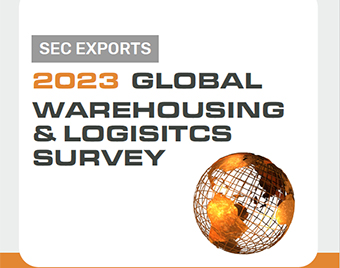2023 Global Warehousing & Logistics Survey
Discover insights from the 2023 Global Warehousing & Logistics Survey, highlighting trends, challenges, and innovations in supply chain management for industry professionals.
Open File
18.03.2024
Robotics-as-a-service (RAAS) solves two problems facing many businesses today.
You want to automate as much as possible because advances in robotics are allowing others to operate warehouses most cost-effectively. But you’re unsure where to start because you’re unfamiliar with the latest technologies available.
You’re also wary of the high investment required. Many still consider robotics to be a high-risk project, taking a long time to implement and with a delayed return on investment.
On top of both these concerns is the risk of investing in technology that quickly becomes obsolete. You don’t want to invest in solutions that won’t be viable in the long term.
RAAS is your answer to these challenges. It gives you fast access to state-of-the-art robotics, along with the expert support needed to install and maintain them. All this comes on a pay-as-you-go basis, avoiding high upfront capital costs.
In this guide, we explore how RAAS can benefit the warehousing operation in your business.
We’ve become familiar with paying for services in monthly instalments. Increasingly we buy on a pay-as-you-go basis, whether it’s for apps, entertainment services or cars.
It’s a model that suits us because there’s no upfront cost and the supplier can keep the product we use up to date.
RAAS works in the same way. You don’t buy your warehouse robots, you subscribe to a service that provides them. This takes them off the balance sheet as a capital asset, putting what you pay into operating expenses.
RAAS makes it easier for you to start using robotics, for a much lower cost.
It still takes time to implement the automation systems, but you’re supported by experts. They know how to best use the technology in warehouse situations, and they’ll continue to support you once the systems go live.
The technology behind warehouse robotics is advancing quickly. Wearable technology, RFID, GPS and AI impact the functionality and variety of robots entering operation.
The types of robots available through RAAS typically include:
Hiring, rather than buying, robots brings a number of significant advantages. While you don’t own the robots themselves, you still get the efficiency benefits that come with automation.
Your RAAS provider has experience in how others are making the best use of robotics in their business. They also understand the capabilities and limitations of their various automation systems.
This knowledge allows them to help you design and build a solution that’s tailored to your business. With their support, the design, testing, installation and training should be delivered within an acceptable timescale.
The huge investment budgets previously required for automation have put robotics out of reach of many medium and small businesses. Large companies reap the efficiency benefits of automation, widening the gap between them and smaller firms unable or unwilling to raise the capital required.
RAAS changes this landscape. Because automation becomes an operating expense rather than a huge investment, it’s become accessible to smaller businesses. It’s reduced risk as well as budgets.
This is opening the way for small and medium-sized enterprises to benefit from the often huge efficiency gains brought by automation.
The RAAS business model ensures that the service provider continues to support you once the automation systems are live.
This support goes from regular maintenance and servicing of equipment to scheduled replacements and upgrades.
The maximum effectiveness of your automated systems comes when they operate continuously, in line with your requirements. A robust support regime minimises downtime, and makes recommendations for ongoing improvements.
While warehouse robotics can be implemented based on your typical day-to-day operations, in reality, these day-to-day requirements will change. There’s variation in stock movement due to seasonality and other factors that influence supply and demand.
There can also be changes in the number of staff you have available. From time to time your human team may need the support of additional devices for receiving, picking, packing and movement.
A RAAS approach makes adaptation easier. You can bring in more robotic hardware as required and return it when the period of peak demand is over.
There’s also flexibility in access to newer technologies. Because your RAAS supplier is keeping up to date with the latest in automated hardware and software, you’ll benefit more quickly than if you bought hardware outright.
The benefits of warehouse automation are significant when systems are implemented in line with an optimised warehouse design.
Manual and movement tasks are carried out more efficiently. Staff are freed up from mundane roles, taking on jobs that are more satisfying. There’s less loss and damage to stock. Space and resources are used more effectively.
These productivity efficiencies bring savings, and the opportunity to achieve more with the same space and workforce. All this means a return on the investment in automation.
Because RAAS is pay-as-you-go, that return on investment occurs faster than if you take the traditional approach of capital investment.
With RAAS you get the same benefits of efficiency, accuracy and increased capacity, for a lower upfront cost. How long it takes to see a return on investment will vary depending on a variety of factors, but it’s certainly much faster with a RAAS solution.
The market for RAAS is predicted to grow significantly over the next few years. It’s removing the barriers holding smaller firms back from investing in automation. Businesses that are willing to move quickly will have an advantage in their market.
As leaders in warehouse design and automation, we have the knowledge and experience to help organisations considering their first implementation of automation, or looking to upgrade their systems and processes.If you want to explore how RAAS could benefit your warehouse operations, get in touch with us below.


Discover insights from the 2023 Global Warehousing & Logistics Survey, highlighting trends, challenges, and innovations in supply chain management for industry professionals.
Open FileWelcome to the world of seamless warehouse operations, where the introduction of Warehouse Management Systems (WMS) have revolutionised the way inventory is managed, tracked, and distributed.
Read MoreWorkplace design and flexible spaces have become more crucial than ever in catering to the evolving work styles and needs of employees.
Read More